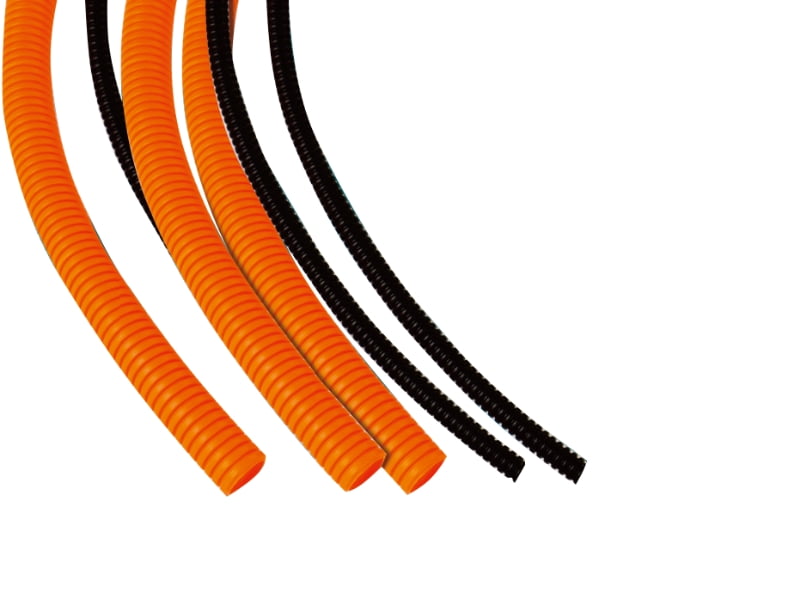What is Corrugated Pipe?
Corrugated Pipe is a flexible, lightweight piping solution characterized by its ridged (corrugated) exterior and smooth interior wall. This unique design provides an optimal balance between structural strength and flexibility. The corrugations create a series of concentric rings that enhance the pipe's hoop strength (typically 50-100 psi for HDPE pipes) while maintaining flexibility with a minimum bend radius of 20 times the pipe diameter.
Key technical specifications of standard Corrugated Pipes:
Material: High-density polyethylene (HDPE), polypropylene (PP), or PVC
Diameter range: 2 inches to 60 inches (50mm to 1500mm)
Wall thickness: 1.5mm to 15mm depending on diameter and pressure rating
Temperature range: -40°F to 180°F (-40°C to 82°C) for HDPE
Chemical resistance: pH range of 2-12 for most applications
Compression strength: 1,500-4,000 psi depending on material and profile
Characteristics of Corrugated Pipe
The structural design of corrugated pipes provides several distinct advantages:
High Strength-to-Weight Ratio: The corrugated profile increases moment of inertia by 300-400% compared to smooth pipes of equivalent weight, allowing for soil load bearing capacities up to 100 kN/m².
Flexibility: Can withstand deflections up to 10% of diameter without structural damage, with elastic recovery properties allowing return to original shape after temporary deformation.
Hydraulic Efficiency: The smooth interior maintains Manning's roughness coefficient (n) of 0.009-0.015, comparable to concrete pipes, while the exterior corrugations provide soil-pipe interaction benefits.
Durability: HDPE corrugated pipes have a service life exceeding 100 years with proper installation, resisting environmental stress cracking with notched constant tensile load (NCTL) ratings >1,500 hours.
Chemical Resistance: Excellent resistance to acids, alkalis, and salts with weight change <0.5% after 30 days immersion in most chemicals at 20°C.
Application Scenarios
Corrugated pipes serve diverse applications across multiple industries:
Stormwater Management: Used in subsurface drainage systems handling flows up to 1000 gallons per minute (3,785 L/min) in 12-inch diameter pipes at 1% slope.
Agricultural Drainage: Perforated corrugated pipes with slot openings of 0.04-0.08 inches (1-2mm) spaced at 3-6 inch (75-150mm) intervals for subsurface irrigation and field drainage.
Road and Railway Construction: As culvert pipes with AASHTO M252/M294 compliance, supporting HS20-44 loading when properly embedded.
Telecommunications Conduit: Innerduct systems with 40-60% reduction in cable pulling tension compared to smooth bore pipes.
Geothermal Systems: Closed-loop ground source heat pump applications with thermal conductivity of 0.42-0.51 W/m·K.
Mining Operations: Ventilation ducts with static pressure ratings up to 5 inches WG (1,245 Pa) for auxiliary mine ventilation.
Maintenance Procedures
Proper maintenance ensures optimal performance and longevity:
Inspection Schedule:
Quarterly visual inspections for surface damage or deformation
Annual CCTV inspections for interior assessment (minimum 20 lux illumination and 540 TV lines resolution)
Biannual flow capacity verification using ultrasonic flow meters with ±2% accuracy
Cleaning Methods:
Hydrojetting at 1,500-3,000 psi (10-20 MPa) with 4-8 gpm (15-30 L/min) flow rates
Mechanical rodding with carbon fiber rods rated for 250 lbs (113 kg) of pushing force
For grease buildup, use pH-neutral enzymatic cleaners (6.5-7.5 pH)
Repair Techniques:
Patch repairs using electrofusion couplings with 2,000 psi (13.8 MPa) tensile strength
Cured-in-place pipe (CIPP) lining with resin systems achieving 12,000 psi (83 MPa) flexural strength
Section replacement following ASTM F2561/F2561M standard practice
Preventive Measures:
Install sediment traps with 50 micron filtration at inlets
Apply UV stabilizers (0.3-0.5% carbon black concentration) for exposed pipes
Maintain minimum 12 inch (300mm) cover depth for buried pipes
Critical maintenance data points:
Maximum allowable deflection: 7.5% of diameter (per ASTM F2648)
Recommended cleaning velocity: 3-5 ft/s (0.9-1.5 m/s)
Acceptable ovality limit: ±5% of nominal diameter
Joint pull-out resistance: ≥1,000 lbs (454 kg) for 12-inch pipes




 English
English


